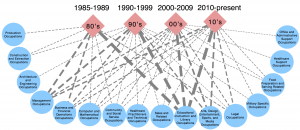Visualization Research Project, First Year Seminar: Everything is a Network
Authors: Daniel Fleming & Gabriel Melmed
Research Question. In the interest of seeing a change over time, my partner and I began researching which majors have changed the most over the past few decades. We found that English had been a very popular major around the 1980s and has been steadily declining ever since. Seeing this change over time peaked our interest, and we were curious as to why this pattern was occurring. We decided to look into how the career paths of English majors changed over the past four decades.
Hypothesis. Our hypothesis is as the world becomes more intelligent and competitive, education for many positions become very specialized. Therefore, majoring in English does not provide as many career options as it used to. We arrived at this hypothesis because we noticed Business majors have been rising around as much as English majors have been declining. With business and management becoming disciplines of their own over recent decades, the proportion of English majors pursuing careers in these jobs should show a visible decline. The proportion of English majors pursuing careers in education and media, two career paths for which an English major provides immediately available skillsets, should also show a visible rise.
Approach. We started with a large list of Wooster alumni that graduated from 1985-2014. We looked at the individuals’ class year as well as what job they had pursued after graduating. We used our annotated data set to create a network that shows which careers English majors form the College of Wooster have pursued, categorized by decade. Our network contains two types of nodes. One node type (red diamonds) shows graduation decade, from the 1980s to the 2010s. The second node type (blue circles) shows major job categories. The width of the links from the decade nodes to job nodes represents the proportion of graduates from a given decade that pursue a given job. In our original network, link width was measured by the number of alumni represented by the link. We normalized the links to get a clearer picture, since the sample sizes from the different decades varied considerably.


Findings. We found English majors to be more widely distributed among career paths and have a higher concentration of business and management occupations in the 1980s and 1990s. Similarly, we found English majors in the 2000s and 2010s to be more concentrated in education and media and less involved in business and management. The observable differences between the 1990s and 2000s confirmed our hypothesis more than anything else. Proportionally, more 1990s graduates went into business and management while more 2000s graduates went into media and education careers. The 1980s and 2010s confirmed our results to a lesser extent due a smaller sample size. If the 1980s and 2010s showed the amount of outliers from commonly pursued jobs that the 1990s and 2000s showed, they would likely confirm our hypothesis more.
Conclusion. In conclusion, our visualization confirmed our hypothesis that English majors have become less broadly applicable, less business and management-orientated, and more education and media-oriented since the 1980s. A potential way to improve our original process would be to keep a consistent sample size among decades in order to prevent the skewed data that we received for the 2010s and 1980s. This issue was partially fixed by our decision to normalize the links, but a consistent sample size would have fixed the issue entirely. A way to take our experiment further would be to either take into account the career paths of English majors from other schools or universities, or to look into the growth of Business majors and their career choices over time. Reading, writing, and literature are valuable components to education at any level and should be studied by everyone. However, based on our findings, those studying English now should look to broaden their educational skillsets to meet the demands of a competitive job market.
